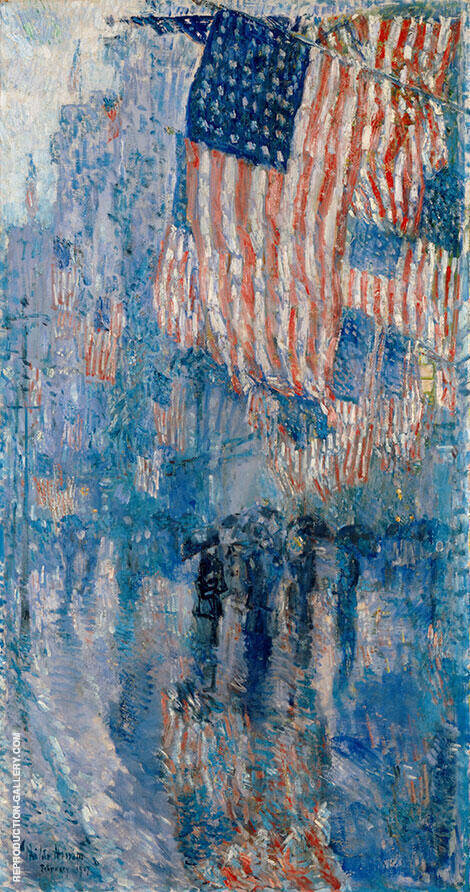The Avenue in the Rain 1917 By Childe Hassam
Childe Hassam The Avenue in the Rain 1917
The Avenue in the Rain; is one of the most famous patriotic paintings of all time.
Frederick Childe Hassam was one of the finest American Impressionist artists of the late nineteenth and early twentieth century. He revolutionized American art and landscape painting alongside fellow impressionists such as Mary Cassatt and John Henry Twachtman.
He is particularly renowned for his cityscapes and coastal scenes. However, one truly stands out among the many wonderful Childe Hassam paintings.
What does The Avenue in the Rain represent?
Painted in February 1917, red and blue tones dominate the composition. The oil painting represents the “stars and stripes” national flag of the United States, depicted with pride.
Hassam’s fleeting brushstrokes also enhance the dappled effects of light and rain.
The New York populace scurry by with their umbrellas up and heads down. Meanwhile, the patriotic glory of the American flag shines from rooftops. Its reflection also radiates from the raindrops and puddles covering the street.
The flags float from unseen supports, reflecting the American people’s positivity and hope in a period of relative peace and prosperity.
Created shortly before the American entry into the maelstrom of the First World War, Hassam (as well as the US population) expected a quick, definitive victory.
In January 1917, Germany extended its “unrestricted submarine warfare” policy. Described in the infamous Zimmerman Telegram (along with a proposed alliance with Mexico), this shift became public knowledge the following month.
Americans were enraged at the extension of this devastating conflict to their borders, and public attitudes changed as a result. As a result, the President announced America’s entry into the war on 6 April 1917.
What inspired Childe Hassam?
As a member of the American Impressionist movement, the French Impressionists profoundly influenced Childe Hassam. Chief amongst these artists was the father of impressionism himself, Claude Monet.
The impressionist’s transitory brushstrokes particularly inspired the American artist. Their revolutionary Frederick Childe Hassam was one of the finest American Impressionist artists of the late nineteenth and early twentieth century.
Hassam produced a staggering 3,000 paintings during his lifetime.
What does The Avenue in the Rain represent?
Painted in February 1917, red and blue tones dominate the composition. This oil painting represents the “stars and stripes” national flag of the United States, depicted with pride in the painting.
Hassam’s quick brushstrokes also enhance the dappled effects of light and rain.
The New York populace scurry by with their umbrellas up and heads down. Meanwhile, the patriotic glory of the American flag shines from rooftops. Its reflection also radiates from the raindrops and puddles covering the street.
The flags float from unseen supports, reflecting the American people’s positivity and hope in a period of relative peace and prosperity.
Created shortly before the American entry into the maelstrom of the First World War, Hassam (as well as the US population) expected a quick, definitive victory.
In January 1917, Germany extended its “unrestricted submarine warfare” policy. Described in the infamous Zimmerman Telegram (along with a proposed alliance with Mexico), this shift became public knowledge the following month.
Americans were enraged at the extension of this devastating conflict to their borders, and public attitudes changed as a result. As a result, the President announced America’s entry into the war on 6 April 1917.
What inspired Childe Hassam?
As a member of the American Impressionist movement, the French Impressionists deeply influenced Childe Hassam. Chief amongst these artists was the father of impressionism himself, Claude Monet.
The impressionist’s transitory brushstrokes particularly inspired the American artist. Their revolutionary painterly techniques especially shine in Childe Hassam’s Poppies Isle of Shoals. After creating this stunningly beautiful floral coastal scene, he returned to the theme on multiple occasions throughout his career.
Monet painted two similar artworks depicting French national celebrations. These were his paintings of The Rue Montorgueil and Rue Saint-Denis, created on June 30, 1878. Both works marked celebrations surrounding the culmination of the Universal Exhibition.
The French street is depicted from a high viewpoint and adorned in red, white, and blue “tricolore” flags. The joyful and celebratory crowd throngs below.
It is likely Hassam viewed Monet’s Paris paintings. He consequently took inspiration for his composition, transferring the theme straight into the heart of Manhattan.
Where is Childe Hassam’s famous oil painting?
Fifth Avenue in New York City is the "real" Avenue in the Rain.
The original painting hangs in the Whitehouse Oval Office in Washington, D.C.
Gifted in 1963 by Thomas Mellon Evans (a wealthy American Financier), it originally adorned John F Kennedy’s blue-themed bedroom.
Avenue in the Rain has since graced multiple presidencies. In this highest of offices, the painting has been admired by Bill Clinton, Barack Obama, Donald Trump, and, more recently, Joe Biden.
Few people realize, but Avenue in the Rain is one of many Childe Hassam flag paintings, some of which remain in the White House permanent collection. Other paintings include 14th July Rue Daunou, Flags on Waldorf, Avenue of the Allies, Flags on Fifty-Seventh Street, The Winter 1918, and Allies Day.
Despite the universal themes of hope, freedom, and patriotism that Avenue in the Rain represents, it is a relatively small painting. Measuring just over 106x56cm, its size perfectly suits the White House interior.
Childe Hassam flag paintings are all featured in our Art Collection of Cityscape oil painting reproductions.
We offer a 100% money back guarantee or replacement service. If for any reason you are dissatisfied with your painting please contact us within 7 days of receipt, advising the reason you are unhappy and we will provide you with all the information you need for its return or replacement.
We ship free to anywhere in the world via FedEx or DHL expedited service with online tracking.
Your painting will be shipped rolled in strong plastic tubing, ready for stretching and/or framing locally. This is the conventional method of transporting hand-painted oil on canvas. Learn more about how your painting is shipped.
We are able to offer a framing service intercontinental U.S. Please contact us if you would like a quotation. Alternatively, should you prefer, we can recommend a framer in your area.
Notes About Your Painting
Please note that replica oil paintings are finished with an additional 10cm (4") of extra canvas on all sides, allowing ample surplus canvas for stretching and framing.
Recently Viewed:
Cannot Find What You Are Looking For?
Reproduction Gallery Information
Customer Service
(Send Us A Message)
Tel: (503) 937 2010
Fax: (503) 937 2011







